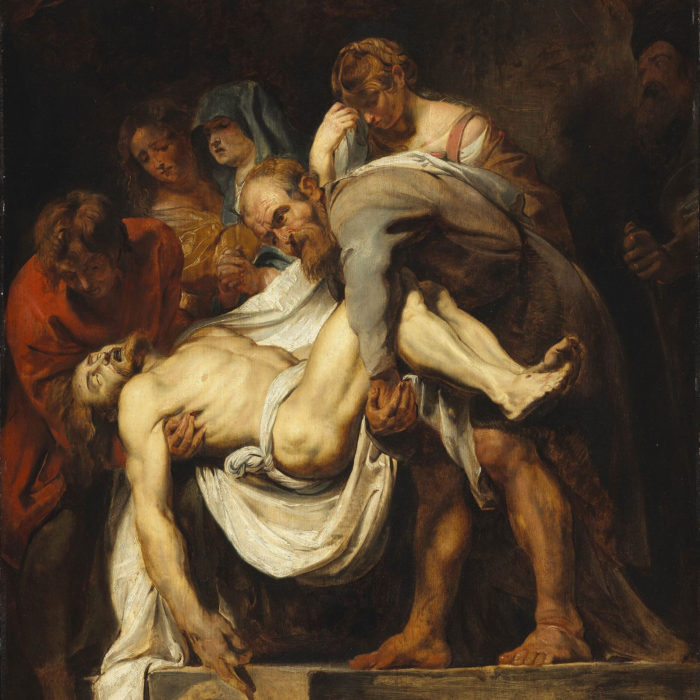- spiritual crucifixion
- Jesus faked his death (swoon theory)
- Jesus had an identical twin brother
- disciples didn’t saw Jesus dying on the cross
- historicity of crucifixion
- 19 early independent sources
- death confirmed by medical science
- John’s medical accuracy despite not being a doctor
- archeology
Jesus’s crucifixion
Origins

Romans used crucifixion as a way to punish people of the lower class, slaves, soldiers, violent rebels & those accused of crime & treason1. For a Jew, a crucified man is believed to be under God’s curse (Deut 21:23). Long before them, the Persians, Assyrians, Scythians & Thracians used that method as well. Alexander the Great is believed to have crucified thousands of people2.
Jesus would have been crucified on a ‘crux commissa‘, a T-shaped cross of 6-8 feet3.
Why was Jesus crucified?
History
Jesus was claiming to be God and threaten the destruction of the Temple of Jerusalem. For Romans, they don’t care. But for a Jew, this was a major crime of blasphemy. Since they don’t have the right to inflict capital punishment4, they asked the Roman prefect Pontius Pilate to crucify him.
Theology
Jesus had to be sacrificed as the Lamb of God to remove the penalty of people’s sins, to save us from the consequences of sin, and to restore God’s relationship with humanity.
Sources
Multiple independent attestation
There’s more than 22 early independent sources for Jesus’ crucifixion:
- 15 from Christians (within 100 years after the crucifixion)
- 7 other non-Christians
New Testament
- Mt 27:35 – after they had crucified him
- Mk 15:24 – then they crucified him
- Lk 23:33 – …, they crucified him and the criminals there, …
- Jn 19:18 – there they crucified him
- Acts 2:23 – this man, delivered up by the set plan and foreknowledge of God, you killed, using lawless men to crucify him
- Acts 4:10 – Jesus the Nazarene was crucified
- Acts 10:39 – put him to death by hanging him on a tree
- Rom 6:6 – we know that our old self was crucified with him
- 1 Cor 1:13, 1:22-23, 2:2, 2:7-8
- 2 Cor 13:4 – for indeed he was crucified out of weakness
- Gal 2:20, 3:1, 3:13, 5:24, 6:14
- 1 Thess 5:8-10 – but to gain salvation through our Lord Jesus Christ, who died for us
- Phil 2:8 – he humbled himself, becoming obedient to death, even death on a cross
- Col 2:14 – he also removed it from our midst, nailing it to the cross
Apostolic Church Fathers
- Papias
- Ignatius of Antioch
- 1 Clement
External evidence
We have 7 non-Christian sources outside the New Testament to confirm the crucifixion of Jesus.
Josephus
Antiquities Of The Jews (93 CE)
“Now around this time lived Jesus, a wise man. For he was a worker of amazing deeds and was a teacher of people who gladly accept the truth. He won over both many Jews and many Greeks. Pilate, when he heard him accused by the leading men among us, condemned him to the cross, (but) those who had first loved him did not cease (doing so)…”
Tacitus
Annals Of Imperial Rome (115 CE)
“… Christus, from whom the name had its origin, suffered the extreme penalty during the reign of Tiberius at the hands of one of our procurators, Pontius Pilatus, …”
Talmud
(70 – 200 CE)
“It was taught: On the day before the Passover, they hanged Jesus. A herald went before him for forty days (proclaiming), “He will be stoned because he practiced magic and enticed Israel to go astray. Let anyone who knows anything in his favour come forward and plead for him.” But nothing was found in his favour, and they hanged him on the day before the Passover.” (b. Sanhedrin 43a)
Lucian of Samosata
The Death Of Peregrinus (2nd century CE)
“The Christians, you know, worship a man to this day—the distinguished personage who introduced their novel rites, and was crucified on that account…”
Thallus
(52 CE)
“On the whole world there pressed a most fearful darkness; and the rocks were rent by an earthquake, and many places in Judea and other districts were thrown down. This darkness Thallus, in the third book of his History, calls, as appears to me without reason, an eclipse of the sun.”
Mara bar Serapion
Letter to his son (73 CE)
“What benefit did the Athenians obtain by putting Socrates to death? Famine and plague came upon them as judgment for their crime. Or, the people of Samos for burning Pythagoras? In one moment their country was covered with sand. Or the Jews by murdering their wise king?…After that their kingdom was abolished. God rightly avenged these men…The wise king…Lived on in the teachings he enacted.”
Phlegon
(2nd century CE) His works are lost but it’s mentioned by Origen’s Contra Celsum (book #2, chapter 33)
“And with regard to the eclipse in the time of Tiberius Caesar, in whose reign Jesus appears to have been crucified, and the great earthquakes which then took place …”
Criteria of embarrassment
Contrary to the claims of the Holy Quran, the Ascension of Isaiah and the Gnostic gospels, the physical crucifixion of Jesus bear no mark of being made up.
- men got crucified all the time (nothing extraordinary)
- highly attested in early independent sources
- crucifixion was considered as a curse
(Deut 21:22-23)- having God being defeated by crucifixion is an absurd idea
(1 Cor 1:23) - the Messiah wasn’t supposed to die on the cross
- having God being defeated by crucifixion is an absurd idea
- even atheists scholars agree on this fact
“Jesus’ death by crucifixion under Pontius Pilate is as sure as anything historical can ever be.”5
John Dominic Crossan
Jesus’ crucifixion is a fact of history. But, was He dead?
The death of Jesus
In the ancient historical records, only one person had survived Roman crucifixion, but not without critical injuries and healing from the best medical care that was available6. All the rest died painfully, including Jesus.

Medical analysis
- blood sweat in Gethsemane
(Lk 22:44): hematidrosis - flagellation / scourging at the pillar9: hypovolemic shock
- crown of thorns10: …
- carrying of the cross11: no more strength to carry due to severe injury
- crucifixion12: slow death by asphyxiation
- crurifragium
(Jn 19:32-33): no broken legs (assume he was already dead) - blood & water from heart
(Jn 19:34): pericardial effusion & pleural effusion
These marks can also be noticed on the Shroud of Turin.

Blood sweat in the garden
Jesus’ bleeding sweat in the garden of Gethsemane (Lk 22:44) a rare phenomenon is called “hematidrosis“, due to a high level of psychological stress (Jesus knew that He would have to suffer a lot). This would make his skins to be very sensitive to any torture.

Flagellation
Roman flogging usually consists of 39+ lashes. They use the whip of braided leather thongs with metal balls woven into them, including a piece of sharp bones to cut the flesh away. It’s so painful that many people died of this before even being crucified! The experience can provoke “hypovolemic shock“:
- heart races to try to pump blood that isn’t there
- blood pressure drops, causing fainting or collapse
- kidneys stop producing urine to maintain what volume is left
- the person becomes very thirsty as the body craves fluids to replace the lost blood volume (this explain why Jesus said “I thirst” on the cross
(Jn 19:28), because He lost so much blood)

Carrying of the cross
Jesus was so damaged by the flagellation that He didn’t even have enough strength to carry his cross. Simon of Cyrene had to do it for Him13.
Traditions tell us that He felt three times.
At that stage, Jesus would be in a critical condition before even been nailed on the cross.

Crucifixion
Crucifixion is a slow death by asphyxiation. Romans used spikes of 5-7 inches driven through the wrists, especially in the median nerve. Since the arms have been stretched, both shoulders would become dislocated. To breathe, the victim must push himself up to exhale, relax down and take a breath. They keep repeating it until they can’t push up and breath no more.

Legs weren’t broken
To accelerate the death of a crucified victim, Romans break their legs (crurifragium) to cause tremendous pain & hemorrhage, which was what happened to the two thieves on the side of Jesus (Jn 19:32). If Jesus’ legs weren’t broken, they would assume that He is already dead.
By Jewish law, a crucified man couldn’t stay overnight: they have to die before, because Jews believed that they were cursed by God, and thus, would defile the land (Deut 21:22-23).

Blood & water
To verify if Jesus was dead, a Roman soldier pierced the side of Jesus with a lance14, reaching his heart, where “water” & blood came out (Jn 19:34). Today is known as “pericardial effusion” & “pleural effusion“, which have the appearance of clear fluid like water, with blood coming out.
At that point, you will be dead.
If not, Jesus would die in the tomb anyway, due to the lack of oxygen (closed tomb) and carrying so many severe damages.
John is the only Gospel author who records that event because he was right there under the cross as an eyewitness with Jesus’s mother (Jn 19:26). Even without been attested in the other sources, it’s not possible that John could have made up a medical claim so accurate without even been trained in that field (he was a fisherman after all), making this event more likely to be true15.
As we can read, it is clear that the Gospel authors didn’t invent the death of Jesus by crucifixion because the whole story flows logically, based on what is known by medical knowledge.
Even if Jesus managed to escape the tomb because He wasn’t dead yet, the disciples would have never been convinced of a glorious and risen Jesus. Seeing a half-dead body crawling out of a tomb is scary. He needs medical care.
Death
The Journal of the American Medical Association wrote a report called “On The Physical Death Of Jesus Christ” (1986), proving that he truly died. The original article was written by Dr. William D. Edwards.
“Clearly, the weight of the historical and medical evidence indicates that Jesus was dead before the wound to his side was inflicted…Accordingly, interpretations based on the assumption that Jesus did not die on the cross appear to be at odds with modern medical knowledge.”
Rise of docetism
The view that Jesus only “appear” as being crucified is a heresy called “docetism” (from the Greek word that mean ‘appear’). From a Jewish perspective, it make sense that it would be scandalous to crucify the God whom they worship, and they would find a way to avoid it by making it ‘appearing’ instead of literal. In the same way, for a Greek, it doesn’t make sense that an all-good God could take flesh in this corrupted material world. In both ways, docetism was a reply against the crucifixion, but only appear at the end of the 1st century, since the first eyewitness were still alive around the 60s to refute against them.
Objections
There are 3 major works that denies the fact that Jesus died on the cross.
- Holy Quran
- Ascension of Isaiah
- Gnostic texts
Holy Quran
The Holy Quran (609 – 632 CE) mention that Jesus only “appears” to have been crucified, not literally.
“That they said (in boast): “We killed Christ Jesus the son of Mary, the Messenger of Allah” but they killed him not, nor crucified him, but so it was made to appear to them, and those who differ therein are full of doubts, …”
Quran 4:157-158
But…
- written 600 years later (not reliable), especially from an outsider
- no eye-witness to confirm the fact
- data comes from the Gospel of Barnabas (unreliable text)
- more evidence from the 1st / 2nd century confirming Jesus’s physical crucifixion (both from Christian & non-Christian sources)
Ascension of Isaiah
The Ascension of Isaiah is a 2nd-century CE text, which describe that Jesus was “spiritually crucified“. But…
- unstable text of history, difficult to reconstruct
- chapter 9-11 describe a trip through the heavens to earth, not a crucifixion in the heavens
- unclear dating (mostly 2nd century)
Gnostic texts
The disciples of Jesus, as eyewitness, arguably defend the historicity of Jesus against the Gnostic since the time of the Apostles. The Gnostic gospels are unreliable documents concerning the facts about the life of Jesus:
- unknown authors
- late dating (starting only from the 2nd century)
- not a lot of historical details like the 4 Gospels, they even have anachronisms
- rejection of the material world, thus, making the historicity of Jesus as impossible because they assume that God can’t became flesh in this corrupted world
Some examples:
Jesus says, “I did not die in reality, but in appearance.”
Second Treatise of the Great Seth
“Never have I suffered in any way, nor have I been distressed. And this people has done me no harm.”
First Apocalypse of James
Stack that up against the other ancient sources, and we can get a majority of the vote for the the Gospel’s report of his physical crucifixion.
“Jesus’ death as consequence of crucifixion is indisputable.” 16
Gerd Lüdemann
- Gary R. Habermas & Michael R. Licona, “The Case of the Resurrection of Jesus”, (Kregel Publications, 2004), 48
- Craig A. Evans & N.T. Wright, “Jesus, the final day: what happened”, (Westminster John Know Press, 2009), 28
- Joseph W. Bergeron, M.D., “The Crucifixion of Jesus: a medical doctor examines the death and resurrection of Christ”, (St. Polycarp Publishing House, 2018), 68
- Josephus, “Antiquities of the Jews”, 20.202
- John Dominic Crossan, “Jesus: A Revolutionary Biography”, (HarperOne, 1995), 145
- Josephus, “The Life of Flavius Josephus”, chapter 75
- Lee Strobel, “The Case for Christ: A Journalist’s Personal Investigation of the Evidence for Jesus”, Zondervan, 1998-2016, page 286-300
- Joseph W. Bergeron, “The Crucifixion of Jesus: a medical doctor examines the death and resurrection of Christ”, (St. Polycarp Publishing House, 2018)
- Mt 27:26, Mk 15:15, Lk 23:22, Jn 19:1
- Mt 27:29, Mk 15:17, Jn 19:2
- Mt 27:32, Mk 15:2, Lk 23:26, Jn 19:17
- Mt 27:35, Mk 15:24, Lk 23:33, Jn 19:18
- Mt 27:32, Mk 15:21, Lk 23:26, Jn 19:17
- Quintillian, “Declamationes maiores”, 6.9
- Strobel, Lee. The Case for Easter (p. 21). Zondervan. Kindle Edition.
- Gerd Lüdemann, “The Resurrection Of Christ: A Historical Inquiry”, Prometheus Books, 2004, page 17